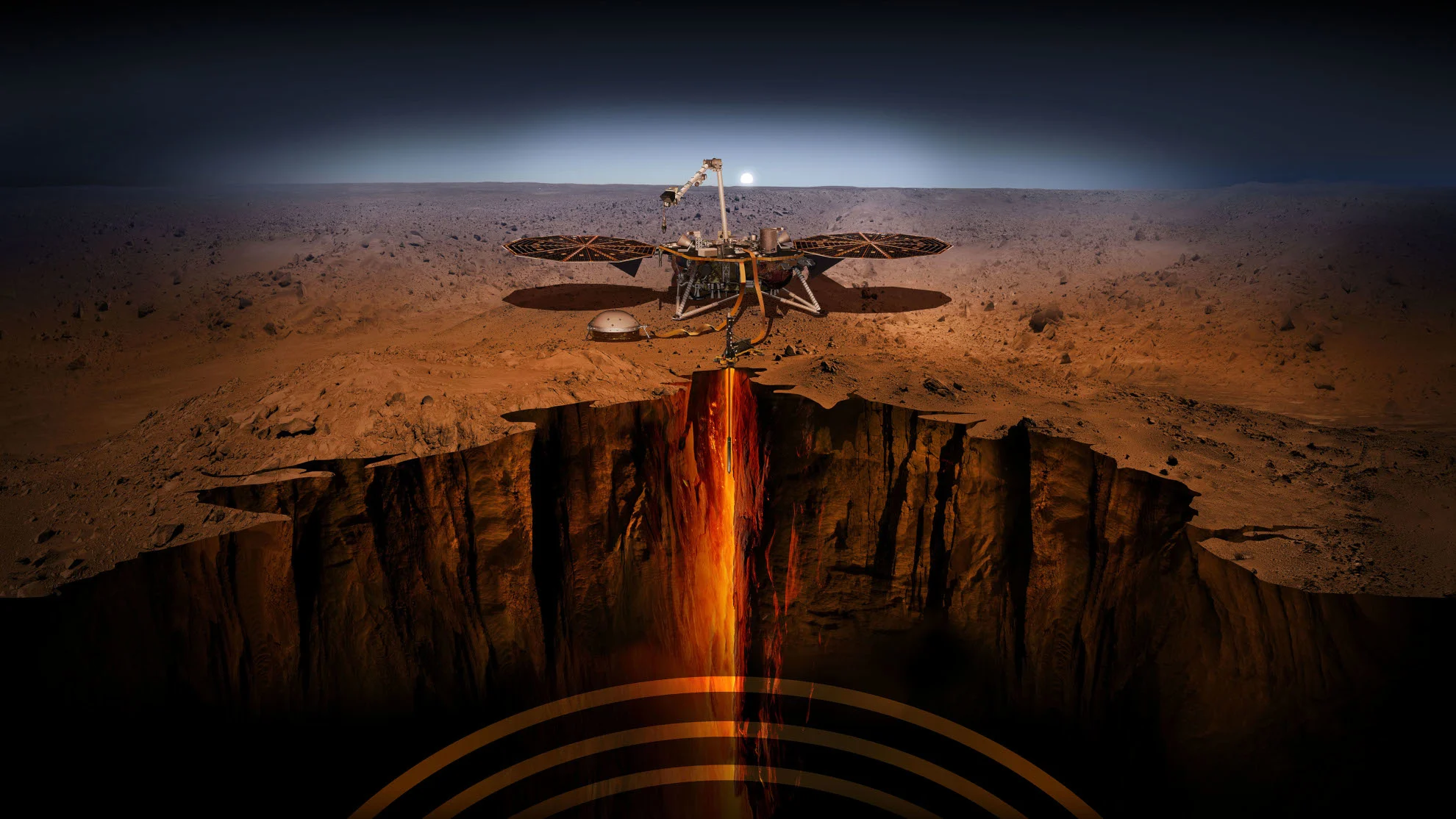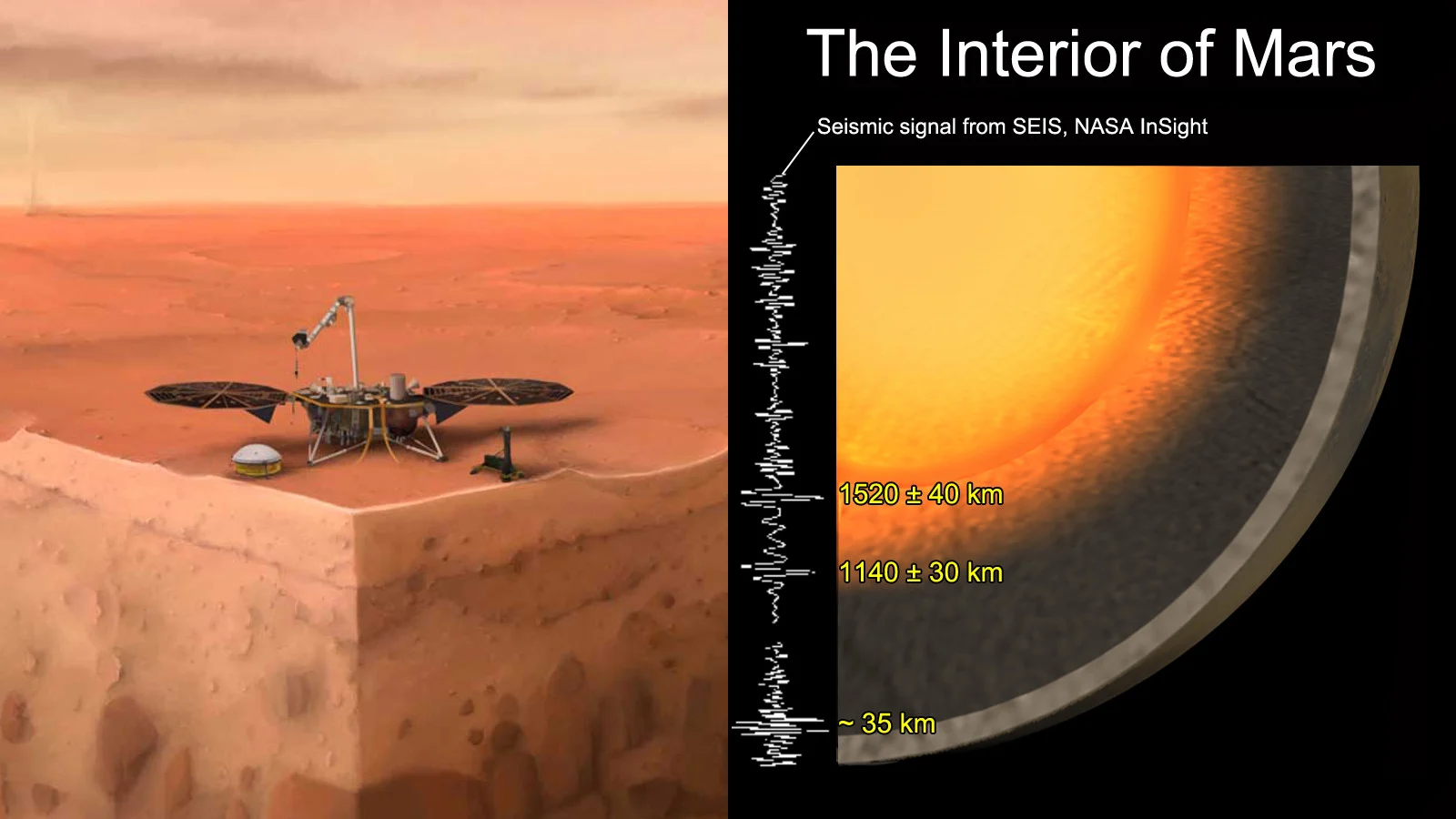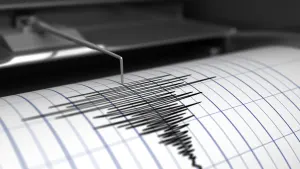
Scientists discover Mars has 'oceans of water' deep underground
"We haven't found any evidence for life on Mars, but at least we have identified a place that should, in principle, be able to sustain life."
NASA's InSight lander may have ended its mission a year and a half ago, but data from the robot's seismograph has revealed what appears be an ocean's worth of liquid water trapped under Mars' surface.
In November 2018, NASA InSight touched down in a flat expanse of land on Mars known as Elysium Planitia. For the next four years, up until December 2022, the lander used one of the most sensitive seismometers ever developed to record tremors known as Marsquakes. Using methods similar to how we discovered what the interior of Earth looks like, scientists used these Marsquakes to construct a detailed model of the inside of Mars.
Further study of InSight's seismic data has now revealed something remarkable.

An artist's conception drawing of NASA Insight is paired here with what the lander's seismic data reveals about the interior structure of Mars. (NASA/IPGP/Nicolas Sarter. NASA/Deng & Levander, 2020/GRL)
READ MORE: Life on Mars? NASA InSight may help solve this mystery
According to new research from scientists with the Scripps Institution for Oceanography and the University of California Berkeley, while the surface and shallow depths of Mars' crust are dry and frozen, there is abundant liquid water trapped in fissures deeper down.
When seismic waves travel through the different layers of a planet's interior, they get reflected around and can arrive at the seismometer from slightly different directions. At the same time, those waves move at different speeds depending on the materials they pass through.
Thus, the waves from a single Marsquake could show up at InSight both from different directions and at slightly different times. By examining these differences, scientists were able to piece together what the interior of the planet looks like.

The seismic waves from one of the strongest Marsquakes detected by InSight are shown here along with the lander's dome-covered Seismic Experiment for Interior Structure (SEIS). (NASA/JPL-Caltech)
In addition to the effect of passing through different types of rock, the presence of liquid water also impacts the travel time of these seismic waves. This has been used here on Earth for mapping out groundwater aquifers.
Applying the same methods to the four years worth of data from InSight revealed the mid-region of Mars' crust, between 11 and 20 kilometres directly underneath the lander, appears to be saturated with water.
"Understanding the Martian water cycle is critical for understanding the evolution of the climate, surface and interior," said Vashan Wright, the lead author of the study from UC San Diego's Scripps Institution of Oceanography. "A useful starting point is to identify where water is and how much is there."
According to their research, if the area of the mid-crust under InSight is representative of the entire mid-crust of the planet, there is enough water contained there to cover the entire surface of Mars in an ocean between 1 and 2 kilometres deep!

This artist's impression shows a cutaway view of Mars's crust directly under NASA's InSight lander. Down to about 10 kilometres under the surface, the rock layers were found to be dry. Between 11 and 20 kilometres below the surface, though, fissure in the rock layers showed signs of the presence of liquid water. (James Tuttle Keane and Aaron Rodriquez/Scripps Institution for Oceanography)
This water is far too deep to access directly. We have drilled down past 12 kilometres here on Earth, via the Kola Superdeep Borehole. However, on Mars, of the 3-metre depth that InSight's own heat probe was anticipated to reach, it only got about 40 centimetres below the surface before it had to give up. That's just deep enough to completely bury the probe.
READ MORE: NASA InSight's 'Mole' forced to end mission due to bizarre Martian soil
While it is out of our reach for direct study, or for use by any future human explorers who visit the planet, the discovery of an ocean's worth of liquid water locked in Mars' crust still has some pretty important implications for the search for life.
"Establishing that there is a big reservoir of liquid water provides some window into what the climate was like or could be like," said Michael Manga, a co-author of the study from UC Berkeley. "And water is necessary for life as we know it. I don't see why [the underground reservoir] is not a habitable environment. It's certainly true on Earth — deep, deep mines host life, the bottom of the ocean hosts life. We haven't found any evidence for life on Mars, but at least we have identified a place that should, in principle, be able to sustain life."
Thumbnail image courtesy NASA/JPL-Caltech










